Indigenous cuisine of the Americas
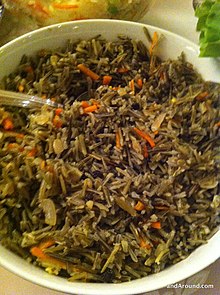
| Part of a series on |
| Native Americans |
|---|
Native American cuisine includes all cuisines and food practices of the indigenous peoples of the Americas. Contemporary Native peoples retain a varied culture of traditional foods, along with the addition of some post-contact foods that have become customary and even iconic of present-day Native American social gatherings (for example, frybread). Foods like cornbread, turkey, cranberry, blueberry, hominy and mush have been adopted into the cuisine of the broader United States population from Native American cultures.
In other cases, documents from the early periods of Native American contact with European, African, and Asian peoples have allowed the recovery and revitalization of indigenous food practices that had formerly passed out of popularity.
The most important Native American crops have generally included corn, beans, squash, pumpkins, sunflowers, wild rice, sweet potatoes, tomatoes, peppers, peanuts, avocados, papayas, potatoes and cacao.[1]
Native American food and cuisine is recognized by its use of indigenous domesticated and wild food ingredients.[2] As the Americas cover a large range of biomes, and there are over 500 currently recognized Native American tribes in the US alone, Native American cuisine can vary significantly by region and culture.[3][failed verification][4] For example, North American Native cuisine differs from Southwestern and Mexican cuisine in its simplicity and directness of flavor. The use of ramps, wild ginger, miners' lettuce, and juniper berry can impart subtle flavours to various dishes.[5][failed verification]
Background[]
In traditional tribal societies, the gathering of shellfish, wild plants, berries and seeds is often done by women. Bison have traditionally been an important source of food for the Plains Indians in the area between the Mississippi River and the Rocky Mountains.
Recipes were initially passed down through oral tradition. Over a period of hundreds of years, some tribes migrated into different climate zones, so by the time European settlers recorded these recipes the cuisine had probably adapted to use local ingredients. Some anthropologists propose that the southwestern Eastern Pueblo, Hopi and Zuni may have retained more of the original elements.[6]
Native American cuisine of North America[]
Country food[]
| Indigenous peoples in Canada |
|---|
 |
|
|
|
Country food, in Canada, refers to the traditional diets of the Indigenous peoples in Canada (known in Canada as First Nations, Metis, and Inuit), especially in remote northern regions where Western food is an expensive import, and traditional foods are still relied upon.[7][8] [9]
The Government of the Northwest Territories estimated in 2015 that nearly half of Northwest Territories residents in smaller communities relied on country food for 75% of their meat and fish intake; in larger communities the percentage was lower, with the lowest percentage relying on country foods (4%) being in Yellowknife, the capital and only "large community".
The most common country foods in the Northwest Territories' area include mammals and birds (caribou, moose, ducks, geese, seals, hare, grouse, ptarmigan), fish (lake trout, char, inconnu (coney), whitefish, pike, burbot) and berries (blueberries, cranberries, blackberries, cloudberries).[10]
In the eastern Canadian Arctic, Inuit consume a diet of foods that are fished, hunted, and gathered locally. This may include caribou, walrus, ringed seal, bearded seal, beluga whale, polar bear, berries, and fireweed.
The cultural value attached to certain game species, and certain parts, varies. For example, in the James Bay region, a 1982 study found that beluga whale meat was principally used as dog food, whereas the blubber, or muktuk was a "valued delicacy".[11] Value also varies by age, with Inuit preferring younger ring seals, and often using the older ones for dog food.[12]
Contaminants in country foods are a public health concern in Northern Canada; volunteers are tested to track the spread of industrial chemicals from emitters (usually in the South) into the northern food web via the air and water.[13]
In 2017, the Government of the Northwest Territories committed to using country foods in the soon-to-open Stanton Territorial Hospital, despite the challenges of obtaining, inspecting, and preparing sufficient quantities of wild game and plants.[14]
In Southern Canada, wild foods (especially meats) are relatively rare in restaurants, due to wildlife conservation rules against selling hunted meat, as well as strict meat inspection rules. There is a cultural divide between rural and remote communities that rely on wild foods, and urban Canadians (the majority), who have little or no experience with them.[15]
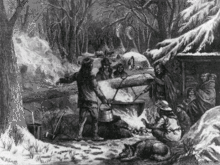
Eastern Native American cuisine[]
The essential staple foods of the Indigenous peoples of the Eastern Woodlands have traditionally been corn (also known as maize), beans, and squash, known as "The Three Sisters" because they were planted interdependently: the beans grew up the tall stalks of the corn, while the squash spread out at the base of the three plants and provided protection and support for the root systems.
Maple syrup is another essential food staple of the Eastern Woodlands peoples. Tree sap is collected from sugar maple trees during the beginning of springtime when the nights are still cold.[16] Birch bark containers are used in the process of making maple syrup, maple cakes, maple sugar, and maple taffy. When the sap is boiled to a certain temperature, the different variations of maple food products are created. When the sap starts to thicken, it can be poured into the snow to make taffy.[17]
Since the first colonists of New England had to adapt their foods to the local crops and resources, the Native influences of Southern New England Algonquian cuisine form a significant part of New England cuisine with dishes such as cornbread, succotash and Johnnycakes and ingredients such as corn, cranberries and local species of clam still enjoyed in the region today.[18]
The Wabanaki tribal nations and other eastern woodlands peoples have made nut milk and infant formula made from nuts and cornmeal.[19][20][21]
Southeastern Native American cuisine[]
Southeastern Native American culture has formed the cornerstone of Southern cuisine from its origins till the present day. From Southeastern Native American culture came one of the main staples of the Southern diet: corn (maize), either ground into meal or limed with an alkaline salt to make hominy, using a Native American technique known as nixtamalization.[22] Corn is used to make all kinds of dishes from the familiar cornbread and grits.
Though a less important staple, potatoes were also adopted from Native American cuisine and have been used in many ways similar to corn. Native Americans introduced the first non-Native American Southerners to many other vegetables still familiar on southern tables. Squash, pumpkin, many types of beans, tomatoes, many types of peppers, and sassafras all came to the settlers via Indigenous peoples. The Virginia Algonquian word pawcohiccora means hickory-nut meat or a nut milk drink made from it.
Many fruits are available in this region. Muscadines, blackberries, raspberries, and many other wild berries were part of Southern Native Americans' diet.
To a far greater degree than anyone realizes, several of the most important food dishes of the Southeastern Indians live on today in the "soul food" eaten by both black and white Southerners. Hominy, for example, is still eaten ... Sofkee live on as grits ... cornbread [is] used by Southern cooks ... Indian fritters ... variously known as "hoe cake", ... or "Johnny cake." ... Indians boiled cornbread is present in Southern cuisine as "corn meal dumplings", ... and as "hush puppies", ... Southerns cook their beans and field peas by boiling them, as did the Indians ... like the Indians they cure their meat and smoke it over hickory coals.
— Charles Hudson, The Southeastern Indians[23]
Southeastern Native Americans traditionally supplement their diets with meats derived from the hunting of native game. Venison has always been an important meat staple, due to the abundance of white-tailed deer in the area. Rabbits, squirrels, opossums, and raccoons are also common.
Livestock, adopted from Europeans, in the form of hogs and cattle, are also kept. Aside from the more commonly consumed parts of the animal, it is traditional to also eat organ meats such as liver, brains, and intestines. This tradition remains today in hallmark dishes like chitterlings, commonly called chitlins, which are the fried large intestines of hogs; livermush, a common dish in the Carolinas made from hog liver; and pork brains and eggs. The fat of the animals, particularly of hogs, is traditionally rendered and used for cooking and frying. Many of the early settlers were taught Southeastern Native American cooking methods.
Selected dishes[]
- Chitterling (Chitlin), usually made from the large intestines of a hog
- Cornbread
- Hominy, coarsely ground corn used to make grits
- Hush puppy, small, savory, deep-fried round ball made from cornmeal-based batter
- Indian fritter
- Livermush, pig liver, parts of pig heads, cornmeal and spices
- Sofkee, corn soup or drink, sour[24]
Great Plains Native American cuisine[]
Indigenous peoples of the Great Plains and Canadian Prairies or Plains Indians have historically relied heavily on American bison (American buffalo) as a staple food source. One traditional method of preparation is to cut the meat into thin slices then dry it, either over a slow fire or in the hot sun, until it is hard and brittle. In this form it can last for months, making it a main ingredient to be combined with other foods, or eaten on its own.
One such use could be pemmican, a concentrated mixture of fat and protein, and fruits such as cranberries, Saskatoon berries, blueberries, cherries, chokecherries, and currants are sometimes added. Many parts of the bison were utilized and prepared in numerous ways, including: "boiled meat, tripe soup perhaps thickened with brains, roasted intestines, jerked/smoked meat, and raw kidneys, liver, tongue sprinkled with gall or bile were eaten immediately after a kill."[25]
The animals that Great Plains Indians consumed, like bison, deer, and antelope, were grazing animals. Due to this, they were high in omega-3 fatty acids, an essential acid that many diets lack.[26]
When asked to state traditional staple foods, a group of Plains elders identified prairie turnips, fruits (chokecherries, June berries, plums, blueberries, cranberries, strawberries, buffalo berries, gooseberries), potatoes, squash, dried meats (venison, buffalo, jack rabbit, pheasant, and prairie chicken), and wild rice as being these staple foods.[27] And pemmican.
Western Native American cuisine[]
In the Pacific Northwest, traditional diets include salmon and other fish, seafood, mushrooms, berries, and meats such as deer, duck, and rabbit.
In contrast to the Easterners, the Northwestern peoples are traditionally hunter-gatherers, primarily. The generally mild climate led to the development of an economy based on year-round abundant food supplies, rather than having to rely upon seasonal agriculture.
In what is now California, acorns can be ground into a flour that has at times served as the principal foodstuff for about 75 percent of the population,[28] and dried meats can be prepared during the dry season.[29]
Southwestern Native American cuisine[]
Ancestral Puebloans of the present-day Four Corners region of the United States, comprising Arizona, Colorado, New Mexico, and Utah, initially practiced subsistence agriculture by cultivating maize, beans, squash, sunflower seeds, and pine nuts from the pinyon pine, and game meat including venison and cuniculture, and freshwater fish such as Rio Grande cutthroat trout and rainbow trout are also traditional foods in the region.[citation needed]
Ancestral Puebloans are also known for their basketry and pottery, indicating both an agricultural surplus that needed to be carried and stored, and clay pot cooking. Grinding stones have been used to grind maize into meal for cooking. Archaeological digs indicate a very early domestication of turkeys for food.[citation needed]
New Mexican cuisine is heavily rooted in both Pueblo and Hispano food traditions, and is a prevalent cuisine in the American Southwest, especially in New Mexico.[citation needed]
The 2002 Foods of the Southwest Indian Nations won a James Beard Award, the first Native American cookbook so honored.[30][31] Publishers had told the author, Lois Ellen Frank, that there was no such thing as Native American cuisine.[32]
Alaskan native cuisine[]
Alaska native cuisine consists of nutrient-dense foods such as seal, fish (salmon), and moose. Along with these, berries (huckleberries) and bird eggs are traditionally consumed by Alaska Natives.[33]
Seal, walruses, and polar bear are the large game that Alaska Natives hunt. Smaller game includes whitefish, Arctic char, Arctic hare, and ptarmigan.
Due to weather, edible plants like berries are only available to be consumed in the summer, so the people have a diet very high in fat and protein, but low in carbohydrates.
The game that is hunted is also used for clothing. The intestines of large mammals are used to make waterproof clothing and caribou fur is used to make warm clothing.[34]
Dishes[]



- Acorn bread
- Acorn mush, from the Miwok people[35]
- Akutaq, also called "Eskimo ice cream", made from caribou or moose tallow and meat, berries, seal oil, and sometimes fish, whipped together with snow or water
- Bannock, a bread of European origin, cooked over an open fire
- Bean bread, made with corn meal and beans, popular among the Cherokee[36]
- Bird brain stew, from the Cree nation[37]
- Black drink or asi, a Southeastern ceremonial drink made from the yaupon holly
- Buffalo stew, from the Lakota and Cherokee people, also called tanka-me-a-lo[38]
- Chinook olives, a type of cured acorn eaten by the aboriginal people of the Columbia River Valley
- Cornbread and corn pone—the word pone derives from the word for 'bread' in some Eastern Algonquian languages, such as Powhatan apon[39] and Lenape ahpòn[40]
- Dried meats like jerky and smoked salmon strips
- Filé powder, made from sassafras leaves, used by the Choctaw for flavoring and thickening soups and stews as well as for herbal medicine
- Frybread, a dish made from ingredients distributed to Native Americans living on reservations
- Green chili stew
- Hopi tea, an herbal tea made from Thelesperma megapotamicum
- Mutton stew, from the Navajo people
- Nokake, Algonquian hoecakes, made of cornmeal
- Nut milk, from the Wabanaki[19]
- Pemmican, a concentrated food consisting of dried pulverized meat, dried berries, and rendered fat.[41][42][43]
- Piki bread, from the Hopi people
- Psindamoakan, a Lenape hunter's food made of parched cornmeal mixed with maple sugar
- Pueblo bread[44]
- Salted salmon, an Inuit dish of brined salmon in a heavy concentration of salt water, left for months to soak up salts
- Sapan (pronounced [ˈsaːpːʌn]),[45] cornmeal mush, a staple of Lenape cuisine
- Stink fish, an Inuit dish of dried fish, kept underground until ripe, for later consumption; also done with fish heads
- Succotash, a dish of beans and corn
- Sumac lemonade,[46] a Native American beverage made from sumac berries
- Tiswin, a term used for several fermented beverages in the Southwest, including a corn or fruit beer of the Apache and a saguaro fruit beer of the Tohono O'odham
- Walrus flipper soup, an Inuit dish made from walrus flippers
- Wojapi, a Plains Indian pudding of mashed, cooked berries
Native American cuisine of the Circum-Caribbean[]
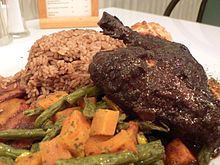
This region comprises the cultures of the Arawaks, the Caribs, and the Ciboney. The Taíno of the Greater Antilles were the first New World people to encounter Columbus. Prior to European contact, these groups foraged, hunted, and fished. The Taíno cultivated cassava, sweet potato, maize, beans, squash, pineapple, peanut, and peppers. Today these cultural groups have mostly assimilated into the surrounding population, but their culinary legacy lives on.
- Ajiaco, same as pepperpot, a soup believed to have originated in Cuba before Columbus' arrival. The soup mixes a variety of meats, tubers, and peppers.
- Barbacoa, the origin of the English word barbecue, a method of slow-grilling meat over a fire pit.
- Jerk, a style of cooking meat that originated with the Taíno of Jamaica. Meat was applied with a dry rub of allspice, Scotch bonnet pepper, and perhaps additional spices, before being smoked over fire or wood charcoal.
- Casabe, a crispy, thin flatbread made from cassava root widespread in the Pre-Columbian Caribbean and Amazonia.
- Bammy, a Jamaican bread made from cassava and water, today this bread is fried and made with coconut milk.
- Guanime, a Puerto Rican food similar to the tamale; made with cornmeal or cornmeal and mashed cassave together.
- Pasteles, a dish that may have also been called hallaca and originated from Puerto Rico. Pasteles were once made with cassava and taro mashed into a masa onto a taro leaf. They are then stuffed with meat and wrapped.
- Funche or fungi, a cornmeal mush.
- Cassareep, a sauce, condiment, or thickening agent made by boiling down the extracted juices of bitter cassava root.
- Mama Juana, a tea made in Hispaniola (Dominican Republic and Haiti).
- Pepperpot, a spicy stew of Taíno origin based on meat, vegetables, chili peppers, and boiled-down cassava juice, with a legacy stretching from Cuba, Colombia coast and to Guyana.
- Bush teas, popular as herbal remedies in the Virgin Islands and other parts of the Caribbean, often derived from indigenous sources, such as ginger thomas, soursop, inflammation bush, kenip, wormgrass, worry wine, and many other leaves, barks, and herbs.
- Ouicou, a fermented, cassava-based beer brewed by the Caribs of the Lesser Antilles.[citation needed]
- Taumali or taumalin, a Carib sauce made from the green liver meat of lobsters, chile pepper, and lime juice.
Native American cuisine of Mesoamerica[]

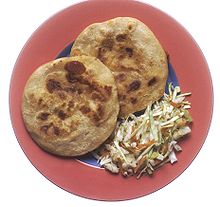
The pre-conquest cuisine of the Native Americans of Mesoamerica made a major contribution to shaping modern-day Mexican cuisine, Salvadoran cuisine, Honduran cuisine, Guatemalan cuisine. The cultures involved included the Aztec, Maya, Olmec, Pipil and many more (see the List of pre-Columbian civilizations).
Some known dishes[]
- Alegría, a candy made from puffed amaranth and boiled-down honey or maguey sap, in ancient times formed into the shapes of Aztec gods
- Balché, Mayan fermented honey drink
- Champurrado, a chocolate drink[47]
- Chili
- Corn tortillas
- Guacamole
- Huarache
- Mezcal
- Mole
- Pejelagarto, a fish with an alligator-like head seasoned with amashito chile and lime [48][better source needed]
- Pozole
- Pulque or octli, an alcoholic beverage of fermented maguey juice
- Pupusas, thick cornmeal flatbread from the Pipil culture of El Salvador
- Salsa
- Tacos
- Tamales
- Tepache, pineapple beer
- Tlacoyos (gordita)
- Xocolātl
Native American cuisine of South America[]




Andean cultures[]
This currently includes recipes known from the Quechua, Aymara and Nazca of the Andes.
- Grilled guinea pig, a native to most of the Andes region, this small rodent has been cultivated for at least 4000 years.
- Fried green tomatoes, a nightshade relative native to Peru.
- Saraiaka, a corn liquor.
- Chicha, a generic name for any number of indigenous beers found in South America. Though chichas made from various types of corn are the most common in the Andes, chicha in the Amazon Basin frequently use manioc. Variations found throughout the continent can be based on amaranth, quinoa, peanut, potato, coca, and many other ingredients.
- Chicha morada, a Peruvian, sweet, unfermented drink made from purple corn, fruits, and spices.
- Colada morada, a thickened, spiced fruit drink based on the Andean blackberry, traditional to the Day of the Dead ceremonies held in Ecuador, it is typically served with guagua de pan, a bread shaped like a swaddled infant (formerly made from cornmeal in Pre-Columbian times), though other shapes can be found in various regions.
- Quinoa porridge.
- Ch'arki, a type of dried meat.
- Humitas, similar to modern-day tamales, a thick mixture of corn, herbs and onion, cooked in a corn-leaf wrapping. The name is modern, meaning bow-tie, because of the shape in which it's wrapped.
- Locro (from the Quechua ruqru) is a hearty thick stew popular along the Andes mountain range. It one of the national dishes of Argentina and Bolivia.
- Mazamorra morada, a thick, sweet pudding made from ground purple corn and fruit. Sold in mix form in Peru.[49]
- Mate de coca, a Peruvian tea made from steeped coca leaves. It is commonly sipped by indigenous people living at high altitudes in the Andes to prevent elevation illnesses.
- Pachamanca, stew cooked in a hautía oven.
- Papa a la Huancaína, Peruvian potatoes covered in a spicy, peanut-based sauce called Huancaína (Wan-ka-EE-na) sauce.
- Patasca, spicy stew made from boiled maize, potatoes, and dried meat.[50]
- Ceviche, raw fish marinated in lime juice. One of Peru's national dishes.
- Cancha or tostada, fried golden hominy.
- Llajwa, salsa of Bolivia.
- Llapingachos, mashed-potato cakes from Ecuador.
- Tocosh (togosh), a traditional Quechua food prepared from fermented potato pulp.
Other South American cultures[]
- Angu, an indigenous Brazilian type of corn mush.
- Arepa, a maize-based bread originating from the indigenous peoples of Colombia and Venezuela.
- Vori vori, a Paraguayan soup with cornmeal dumplings.
- Cauim, a fermented beverage based on maize or manioc broken down by the enzymes of human saliva, traditional to the Tupinambá and other indigenous peoples of Brazil.
- Chipa, a wide variety of corn flour or manioc-based breads traditional to Paraguay.
- Curanto, a Chilean stew cooked in an earthen oven originally from the Chono people of Chiloé Island.
- Kaguyjy, a Guarani-derived locro corn mush that become part of the national Paraguayan cuisine.
- Kiveve, a sweet or savory dish from Paraguay consisting of puréed pumpkin and other ingredients cooked over a fire.
- Lampreado or payaguá mascada, a starchy, manioc-based fried cake from Paraguay and the northeast of Argentina.
- Lapacho or taheebo, a medicinal tree-bark infusion.
- Maniçoba, dish of boiled manioc leaves and smoked meat indigenous to the Brazilian Amazon.
- Mate (beverage).
- Mbeju, a pan-cooked cake utilizing manioc starch.
- Merken, a ají powder from the Mapuche of Patagonia.
- Mocotó, a Brazilian stew with cow's feet, beans, and vegetables.
- Moqueca, a Brazilian seafood stew.
- Paçoca, from the Tupi "to crumble," describes two different dishes of pulverized ingredients: one with peanuts and sugar, and the other with dried meat, ground manioc, and onion.
- Pamonha, a Brazilian tamale.
- Pira caldo, Paraguayan fish soup.
- Sopa paraguaya, a corn-flour casserole esteemed as the national dish of Paraguay, related to chipa guasu.
- Soyo, shortened from the Guarani name so’o josopy, a Paraguayan soup based on meat crushed in a mortar.
- Tacacá, a Brazilian stew of tucupi, jambu leaves, and shrimp, typically served in a dried gourd.
- Tereré or ka'ay, a cold-brewed version of yerba mate.
- Tucupi, manioc-based broth used in Brazilian dishes such as pato no tucupi and tacacá.
- Yerba mate, a tea made from the holly of the same name, derived from Guaraní.
Cooking utensils[]

The earliest utensils, including bowls, knives, spoons, grinders, and griddles, were made from all kinds of materials, such as rock and animal bone. Gourds were also initially cultivated, hollowed, and dried to be used as bowls, spoons, ladles, and storage containers.
Many Native American cultures also developed elaborate pottery traditions for making bowls and cooking pots, and basketry for making containers. Nobility in the Andean and Mesoamerican civilizations were even known to have utensils and vessels smelted from gold, silver, copper, or other minerals.
- Batan, an Andean grinding slab used in conjunction with a small stone uña
- Burén, a clay griddle used by the Taíno.
- Comal, a griddle used since Pre-Columbian times in Mexico and Central America for a variety of purposes, especially to cook tortillas.
- Cuia, a gourd used for drinking mate in South America.
- Metate, a stone grinding slab used with a stone mano or metlapil to process meal in Mesoamerica and one of the most notable Pre-Columbian artifacts in Costa Rica.
- Molinillo, a device used by Mesoamerican royalty for frothing cacao drinks.
- Molcajete, a basalt stone bowl, used with a tejolote to grind ingredients as a Mesoamerican form of mortar and pestle.
- Paila, an Andean earthenware bowl.
- Cooking baskets were woven from a variety of local fibers and sometimes coated with clay to improve durability. The notable thing about basket cooking and some native clay pot cooking is that the heat source, i.e. hot stones or charcoal, is used inside the utensil rather than outside. (Also see Cookware and bakeware.)
Crops and ingredients[]
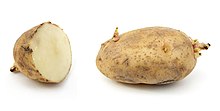


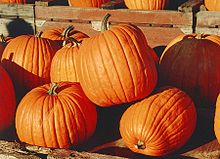
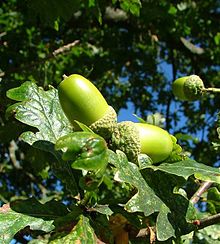
Non-animal foodstuffs[]
- Acorn—used to make flour and fertilizers for plants
- Achira—edible tubercule
- Achiote—annatto seed, a seasoning
- Acuyo—a seasoning
- Agarita—berries
- Agave nectar—a sweetener
- Allspice—a seasoning
- Amaranth
- American chestnut
- Arazá
- American lotus—seeds & root, leaves for baking coverings
- Amole
- Aspen—inner bark and sap (both used as sweetener)
- Avocado
- Barbados cherry or acerola
- Beans—throughout the Americas
- Bear grass
- Beautyberry
- Beech nuts
- Birch bark
- Birch syrup—sweetener
- Bitterroot
- Blackberries
- Blow wife seeds
- Blueberries
- Bodark seeds—also called Osage orange, hedge apple, monkeybrain
- Bog rosemary—poisonous, but leaves can be brewed into tea regardless
- Box elder—inner bark (used as sweetener)
- Buckeye—(same rules apply as acorn)
- Butia—palm fruits from South America
- Buffalo gourd—(wild ancestor of all squash/ pumpkin)
- Bur cucumber
- Cacao
- Cactus (various species)—fruits and young pads (see nopales)
- California poppy seeds—(There are eastern American poppies also, but they are believed to have always been so rare, inclusion in the human diet is highly unlikely)
- Camas root
- Canella winterana—white cinnamon (used as a seasoning before cinnamon)
- Cashew nuts
- Cassava—primarily South America
- Cattails—rootstocks
- Century plant (mescal or agave)—crowns (tuberous base portion) and shoots
- Chia seed
- Chicle—chewing gum
- Chili peppers (including bell peppers)—seasoning
- Cherimoya
- Chokecherries
- Cholla fruits
- Coca—South and Central America
- Cow parsnip root
- Cranberries
- Crowberry
- Culantro—used as a seasoning before cilantro
- Currants
- Custard-apple
- Dandelion
- Datil—fruit and flowers
- Devil's claw
- Dewberry
- Dropseed grasses (various varieties)—seeds
- Dwarf plantain
- Eastern redbud—flowers as spice, fruit
- Eastern red columbine—nectar only
- Elderberries
- Emory oak—acorns
- Epazote—a seasoning
- Feijoa—fruit from South America
- Ferns (various edible species, such as fiddleheads)
- Gaylussacias or black huckleberry—grows near wild blueberries, tastes similar, but unrelated
- Goji or wolf berry
- Goldenberry
- Gooseberries
- Groundcherry—multiple species from North and South America
- Guarana
- Guava
- Guaviyú
- Hackberries
- Hawthorn—fruit
- Hazelnut or filbert
- Hierba Luisa
- Hueinacaztli, or ear-flower
- Hickory nuts
- Hogpeanut
- Holly
- Hops
- Horsemint
- Huazontle
- Huckleberries
- Indian cucumber
- Indian potato or hopniss, openowag, cinnamon vine, groundnut (cultivated in Japan as hodoimo, edible root bulbs and beans, dried flowers as spice)
- Indigo bush—sources disagree whether edible, but presumably fruit?
- Jack in the pulpit root
- Jambú
- Jerusalem artichoke
- Jicama
- Juniper berries
- Kaniwa
- Kentucky coffeetree
- Kiwicha
- Lamb's-quarters—leaves and seeds
- Lapacho
- Lechehuana honey
- Lemon-verbena—lemon-flavoring herb
- Lichen (certain species)
- Lilypad root
- Locust—blossoms and pods
- Lúcuma
- Maca
- Maize—throughout the Americas, probably domesticated in or near Mexico, including the blue corn variety
- Mamey
- Manzanita
- Maple syrup and sugar, used as the primary sweetener and seasoning in Northern America
- Mesquite—bean pods, flour/meal
- Mexican oregano
- Milkweed
- Mint, various species—American mint is best known in eastern woodlands region
- Mooseberry—called highbush cranberry in Eastern US—actually a type of Viburnum
- Mulberries
- Nopales—cactus
- Okra
- Onions
- Oregon grape—(not a real grape)
- Palmetto
- Surinam cherry
- Papaya
- Passionfruit
- Pawpaw
- Peanuts
- Pecans
- Pennyroyal—American false variety
- Persimmon
- Pigweed —seeds
- Pine (including western white pine and Pinus ponderosa)—inner bark (used as sweetener), sap as chewing gum ingredient, tips for jelly, cuttings for tea, and pinenuts
- Pineapples—South America
- Pinyon—nuts
- Piñonero—nuts
- Pipsissewa
- Plum
- Popcorn flower—herb
- Potatoes—North and South America
- Prickly pears
- Prairie turnips
- Pumpkins
- Purslane—leaves
- Quinoa—South America, Central America, and Eastern North America
- Ramps—wild onion
- Raspberries
- Rice—imported by the Spanish
- rock cress
- Rose pepper
- Sage
- Saguaro cactus—fruits and seeds
- Salt
- Sangre de drago
- Sapote
- Sassafras
- Screwbean—fruit
- Sedge—tubers
- Sea grape or uva de playa
- Serviceberry—also juneberry, saskatoon
- Shepherd's purse—leaves
- Solomon's seal
- Sotol—crowns
- Soursop or guanábana
- Spanish bayonet—fruit
- Spanish lime or mamoncillo
- Common spicebush—a seasoning
- Spikenard—berries and roots for tea, some tribes ate roots (this is a select species, of which there are many in the America's and not all species are edible, though Natives had wide medicinal and practical uses)
- Squash—throughout the Americas
- Stevia—sweetener
- Strawberries
- Sumac—berries
- Sunflower seeds
- Sweet anise
- Sweet potato—South America (misleading name: not a potato)
- Sweetsop or sugar-apple
- Tamarillo
- Teaberry or wintergreen
- Tobacco
- Tomatillo
- Tomato
- Texas persimmons or sugar plum
- Tuckahoe
- Tulip poplar—syrup made from bark
- Tule—rhizomes
- Tumbleweed—seeds
- Tumbo or taxo
- Vanilla—a seasoning
- Vetch—pods
- Wapato root
- White evening primrose—fruit
- White walnuts or butternuts
- Wild carrot—also harbinger of spring, salt and pepper
- Wild celery
- Wild cherries
- Wild grapes—fruit
- Wild honey
- Wild onion
- Wild pea—pods
- Wild roses
- Wild sweet potato—(misleading name: not a potato)
- Wood sorrel—leaves
- Yacón—nectar
- Yaupon holly—leaves
- Yerba buena
- Yerba mate
- Yucca—blossoms, fruit, and stalks
- Zamia—nuts
Hunted or livestock[]

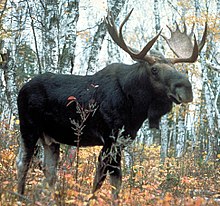
- Antelope
- Armadillo
- Badger
- Bear
- Beaver
- Bighorn sheep
- Bison—originally found throughout most of the North American plains
- Burro—European import
- Camel—extinct in the Americas
- Capybara
- Cattle—European import
- Chipmunk
- Deer
- Dove
- Duck
- Elk
- Ants
- Geese
- Ground hog
- Grouse
- Guanaco—hunted in South America by hunter-gatherer societies, for ex. in Patagonia until the 19th century
- Guinea pig—domesticated in the Andes
- Hog—important European import
- Honey wasp—Brachygastra mellifica, Brachygastra lecheguana, and Polybia occidentalis, a source of honey found from the Southwestern United States to Argentina
- Horse—although imported by Europeans, the horse was still very important to Native American cultures throughout the Americas (famously on the North American Plains) in the historic era
- Hutia
- Iguana
- Livestock
- Llama—domesticated in the Andes
- Locust (cicada)
- Manatee
- Mastodon—extinct
- Moose
- Mourning dove
- Mule—European import
- Muscovy duck—domesticated in Mesoamerica
- Opossum
- Otter
- Passenger pigeon—extinct
- Peccaries
- Pheasant
- Porcupine
- Prairie dog
- Pronghorn (antelope)
- Quail
- Rabbit
- Raccoon
- Sheep—important European import
- Skunk
- Sloth
- Stingless bee—Melipona beecheii and M. yucatanica, Mayan source of honey
- Squirrel
- Turkey
- Turtle
- Yacare caiman
- Wood rat
- Woolly mammoth—extinct
Notable chefs and food writers[]
- Lois Ellen Frank
- Sean Sherman
See also[]
- Plants used in Native American cuisine
- House dish
- Hunter gatherer
- Locavores
- Tlingit cuisine
- Wild onion festival
- Inuit diet
- List of First Nations peoples
- Aboriginal food security in Canada
- Peasant food
- Staple food
- Soul food
- Bush meat (Africa)
- Bushfood (Australia)
- Game (food)
References[]
- ^ a b "Native American Food: Agriculture, Hunting and Gathering, Fishing, and other American Indian food sources".
- ^ "Welcome to NativeTech: Indigenous Food and Traditional Recipes". NativeTech: Native American Technology & Art.
- ^ "The Native American Culinary Association Forum Index". The Native American Culinary Association. Archived from the original on April 22, 2007.
- ^ Severson, Kim (November 23, 2005). "Native Foods Nourish Again". The New York Times. Retrieved January 21, 2015.
- ^ "Native American Recipes". Food.com.
- ^ Berzok, Linda Murray (2005). American Indian Food. Greenwood. ISBN 9780313329890. Retrieved August 16, 2019.
- ^ Usher, Peter J. "Evaluating Country Food in the Northern Native Economy" (PDF). Artic. pp. 105–120.
- ^ Wein, Eleanor E.; et al. (1990). "Food Consumption Patterns and Use of Country Foods by Native Canadians near Wood Buffalo National Park, Canada". Arctic. 44 (3): 196–206. doi:10.14430/arctic1539.
- ^ http://www.enr.gov.nt.ca/sites/enr/files/weights_of_wildlife.pdf "in deriving estimates of the economic value of wildlife used as food (known in northern Canada as country food or traditional food)..." page 2
- ^ "18.3 Country food use in NWT ecozones".
- ^ http://www.enr.gov.nt.ca/sites/enr/files/weights_of_wildlife.pdf page 16
- ^ Ashley, pg 22
- ^ "Country food contaminants: NWT residents undergo tests".
- ^ "Traditional Indigenous food in a hospital? That's the plan for new N.W.T. Facility | CBC News".
- ^ "Kill What You Eat". April 10, 2017.
- ^ www.d.umn.edu (PDF) http://www.d.umn.edu/~tbates/curricularesources/MapleSyruping/MapleSugarbushFAQs.pdf. Retrieved December 15, 2018.
{{cite web}}: Missing or empty|title=(help) - ^ We Choose To Remember More Memories of the Red Lake Ojibwe People, Arrow Printing, Bemidji, MN Copyright 1991 Nerburn, Dr. Kent, Project Director. Bemidji, Minnesota: Arrow Printing. 1991. p. 8.
- ^ Freedman, P. (2019). American Cuisine: And How It Got This Way. (pp. 1-40). New York, NY: Liveright Publishing.
- ^ a b "Wabanaki Enjoying Nut Milk and Butter for Centuries". Atowi. Retrieved January 6, 2021.
- ^ Kamila, Avery Yale (November 8, 2020). "Americans have been enjoying nut milk and nut butter for at least 4 centuries". Portland Press Herald. Retrieved January 6, 2021.
- ^ Diemer-Eaton, Jessica (2014). "Food Nuts of the Eastern Woodlands Native Peoples". www.woodlandindianedu.com. Retrieved January 7, 2021.
- ^ Dragonwagon, Crescent (2007). The Cornbread Gospels. Workman Publishing. ISBN 978-0-7611-1916-6.
- ^ Hudson, Charles (1976). "A Conquered People". The Southeastern Indians. University of Tennessee Press. pp. 498–499. ISBN 0-87049-248-9.
- ^ "Sofkey | The Encyclopedia of Oklahoma History and Culture". www.okhistory.org. Retrieved March 18, 2021.
- ^ "American Indian Health - Foods of Plains Tribes".
- ^ The Dakota Diet: Health Secrets from the Great Plains.
- ^ Colby, Sarah E; et al. (2012). "Traditional Native American Foods". Journal of Ecological Anthropology. 15: 65–73. doi:10.5038/2162-4593.15.1.5.
- ^ Redhawk (2004). "Cooking With Acorns". North American Indian Recipes. "the People's Paths home page!".
- ^ "The History of Jerky: The incomplete but interesting history of jerky". The JerkyFAQ. April 10, 2012.
- ^ Swanson, Stevenson (2003). "Star grazing". chicagotribune.com. Retrieved November 14, 2019.
- ^ Biggers, Ashley M. (September 5, 2018). "The first truly American cuisine is having a revival". CNN. Retrieved November 14, 2019.
- ^ Frederich, Lori (November 20, 2013). "Chef Lois Ellen Frank demystifies .ew Native American cuisine". OnMilwaukee.com. Retrieved November 14, 2019.
- ^ "Traditional Foods in Native America: A compendium of traditional foods stories from American Indian and Alaska Native communities" (PDF).
- ^ "Inuit".
- ^ "Acorn Mush". NativeTech: Native American Technology & Art.
- ^ "Cherokee Bean Bread Recipe". www.pbs.org. Retrieved March 19, 2021.
- ^ "Bird brain stew". NativeTech: Native American Technology & Art.
- ^ "Buffalo Stew (Tanka-me-a-lo)". NativeTech: Native American Technology & Art.
- ^ Rudes, Blair A. (December 15, 2011). "Coastal Algonquian Language Sampler". Coastal Carolina Indian Center. Retrieved November 20, 2014.
- ^ "ahpòn". Lenape Talking Dictionary. Delaware Tribe of Indians. Archived from the original on September 24, 2015. Retrieved November 20, 2014.
- ^ "How Long Does Pemmican Last". May 27, 2017.
- ^ "How To Make Pemmican: A Survival Superfood That Can Last 50 Years - Off The Grid News". Off The Grid News. June 2, 2015. Retrieved November 29, 2018.
- ^ "pemmican | Definition, History, & Facts". Encyclopedia Britannica. Retrieved November 29, 2018.
- ^ "In New Mexico, Bakers Keep the Tradition of Pueblo Bread Alive". Atlas Obscura. Retrieved March 19, 2021.
- ^ "sapàn". Lenape Talking Dictionary. Archived from the original on October 4, 2011. Retrieved June 26, 2011.
- ^ "Sumac Lemonade Recipe". PBS Food. Retrieved March 19, 2021.
- ^ Aguilar, Valerie (2014). "Chocolate - Ancient Drink of the Gods". Hispanic Culture Site. BellaOnline.
- ^ Brandon; Courtney; Jonelle; Amanda. "Mayan Cuisine". Putnam County High School. Archived from the original on April 17, 2009.
- ^ "How to Make Delicious Peruvian Purple Corn Pudding". The Spruce Eats. Retrieved March 20, 2021.
- ^ "Patasca - Pork, Sheep or Beef Head Stew. Bolivian Food and Recipes". BoliviaBella. Retrieved March 20, 2021.
Bibliography[]
- Coe, Sophie D. (1994). America's First Cuisines. Austin, Texas: University of Texas Press. ISBN 978-0-292-71159-4.
- Hetzler, Richard (2010). The Mitsitam Cafe cookbook : recipes from the Smithsonian National Museum of the American Indian. Washington, D.C.: Smithsonian National Museum of the American Indian. ISBN 978-1-55591-747-0.
- Niethammer, Carolyn (1974). American Indian Food and Lore. New York: A Simon & Schuster Macmillan Company. ISBN 0-02-010000-0.
External links[]
| Wikimedia Commons has media related to Foods and ingredients of the indigenous people. |
| Wikimedia Commons has media related to Cuisine of indigenous peoples in North America. |
- Indigenous cuisine of the Americas
- Native American culture
- Native American cuisine
- Latin American cuisine
- North American cuisine
- First Nations culture